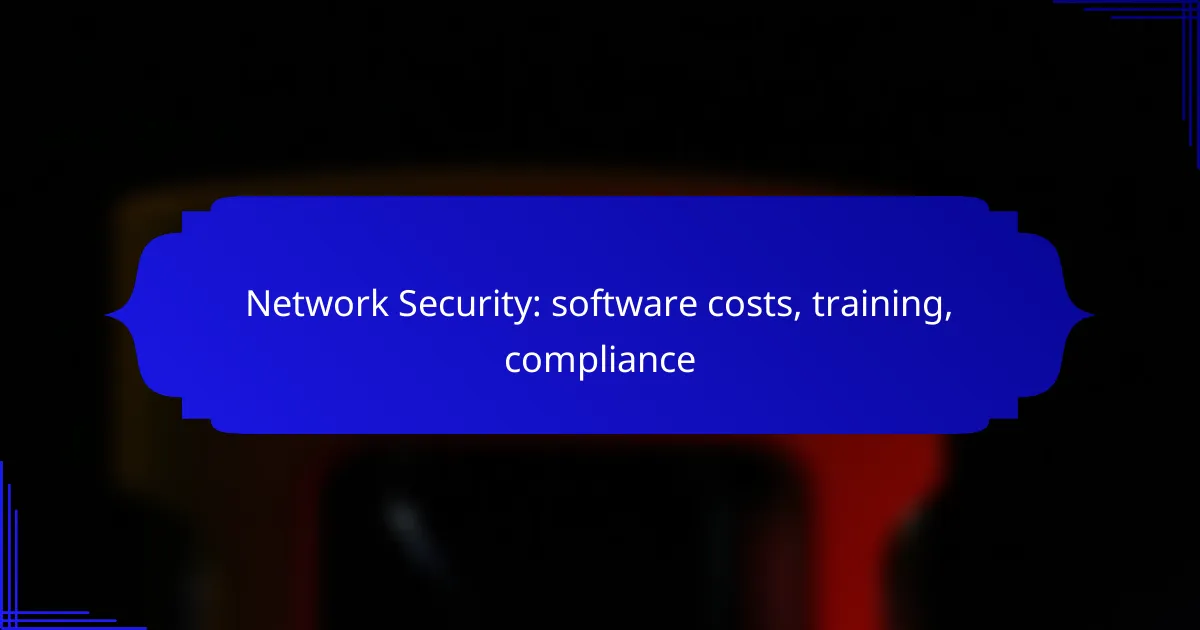Network security is a critical investment for businesses, with software costs in New Zealand varying widely based on features and licensing models. Organizations must evaluate their specific needs and budget while considering the total cost of ownership, which includes not only software expenses but also training and compliance requirements. Proper training for network security professionals is essential, encompassing formal education and hands-on experience to navigate the complexities of cyber threats and regulatory standards.
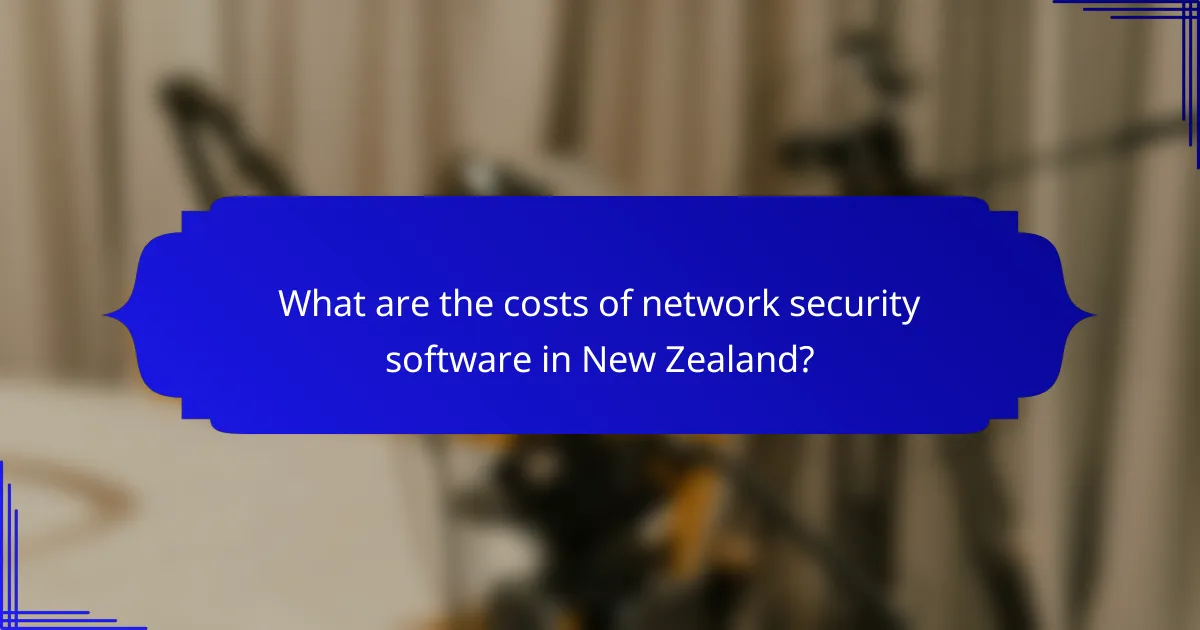
What are the costs of network security software in New Zealand?
The costs of network security software in New Zealand can vary significantly based on the type of solution, features, and licensing models. Businesses typically face expenses related to antivirus, firewall, and cloud security solutions, which can range from hundreds to thousands of New Zealand dollars annually.
Average pricing for antivirus solutions
Antivirus solutions in New Zealand generally range from NZD 50 to NZD 150 per user per year. Some providers offer bulk licensing discounts, which can lower the cost for larger organizations. It’s essential to consider both the features offered and the level of customer support included in the pricing.
Costs for firewall software
Firewall software costs can vary widely, typically falling between NZD 200 and NZD 1,500 depending on the complexity and capabilities of the solution. Basic software firewalls may be sufficient for small businesses, while larger enterprises often require advanced features that come with higher price tags. Additionally, hardware firewalls can add significant costs, often starting at NZD 1,000.
Subscription models for cloud security
Cloud security solutions usually operate on a subscription basis, with costs ranging from NZD 10 to NZD 50 per user per month. These models often include regular updates and support, making them a flexible option for businesses. Organizations should assess their specific security needs to determine the most cost-effective subscription plan.
Factors influencing software costs
Several factors influence the costs of network security software, including the size of the organization, the number of users, and the specific security requirements. Additional features such as advanced threat detection, compliance tools, and integration capabilities can also drive up costs. It’s crucial to evaluate the total cost of ownership, including potential hidden fees for updates or support, to make an informed decision.

How to choose network security software?
Choosing network security software involves assessing your organization’s specific needs, budget, and the software’s capabilities. Prioritize features that align with your security goals while considering the total cost of ownership, including licensing, training, and compliance requirements.
Key features to consider
When selecting network security software, focus on essential features such as threat detection, firewall capabilities, intrusion prevention, and data encryption. Additionally, consider user-friendly interfaces and integration with existing systems to streamline operations.
Evaluate the software’s scalability to ensure it can grow with your organization. Look for options that offer real-time monitoring and reporting to enhance your security posture and facilitate compliance with regulations.
Comparison of top brands
Popular network security software brands include Cisco, Fortinet, and Palo Alto Networks. Cisco offers a comprehensive suite with robust features, while Fortinet is known for its cost-effective solutions suitable for small to medium-sized businesses.
Palo Alto Networks provides advanced threat intelligence and automation capabilities, making it ideal for larger enterprises. Compare pricing models, typically ranging from hundreds to thousands of USD annually, and assess trial options to test functionality before committing.
Vendor reputation and support
Research vendor reputation through customer reviews, industry awards, and case studies to gauge reliability and effectiveness. Strong vendor support is crucial; look for companies that offer 24/7 assistance and extensive documentation.
Consider the availability of training resources, such as online tutorials and certification programs, which can enhance your team’s proficiency with the software. A vendor with a solid support system can significantly reduce downtime and improve your overall security management.

What training is required for network security professionals?
Network security professionals typically need a combination of formal education, certifications, and hands-on training to effectively protect systems from cyber threats. Training often focuses on understanding security protocols, risk management, and compliance with industry regulations.
Essential certifications for New Zealand
In New Zealand, several certifications are highly regarded in the network security field. The Certified Information Systems Security Professional (CISSP) and Certified Ethical Hacker (CEH) are among the most recognized. Additionally, the CompTIA Security+ certification provides foundational knowledge that is beneficial for entry-level professionals.
These certifications not only validate skills but also enhance job prospects in a competitive market. Many employers prefer candidates with these credentials, as they demonstrate a commitment to ongoing professional development.
Recommended training programs
Training programs for network security can vary widely in content and delivery. Programs offered by institutions like the University of Auckland or Wellington Institute of Technology provide comprehensive courses covering essential security principles and practices. Online platforms such as Coursera and Udemy also offer specialized courses tailored to different skill levels.
When selecting a training program, consider factors such as course content, duration, and the reputation of the institution. Look for programs that include hands-on labs and real-world scenarios to enhance learning outcomes.
Online vs. in-person training options
Both online and in-person training options have their advantages in network security education. Online training offers flexibility, allowing professionals to learn at their own pace and often at a lower cost. However, in-person training can provide valuable networking opportunities and immediate access to instructors for questions and clarifications.
Ultimately, the choice between online and in-person training should depend on individual learning preferences, budget, and career goals. A blended approach, combining both methods, can also be effective for comprehensive learning.
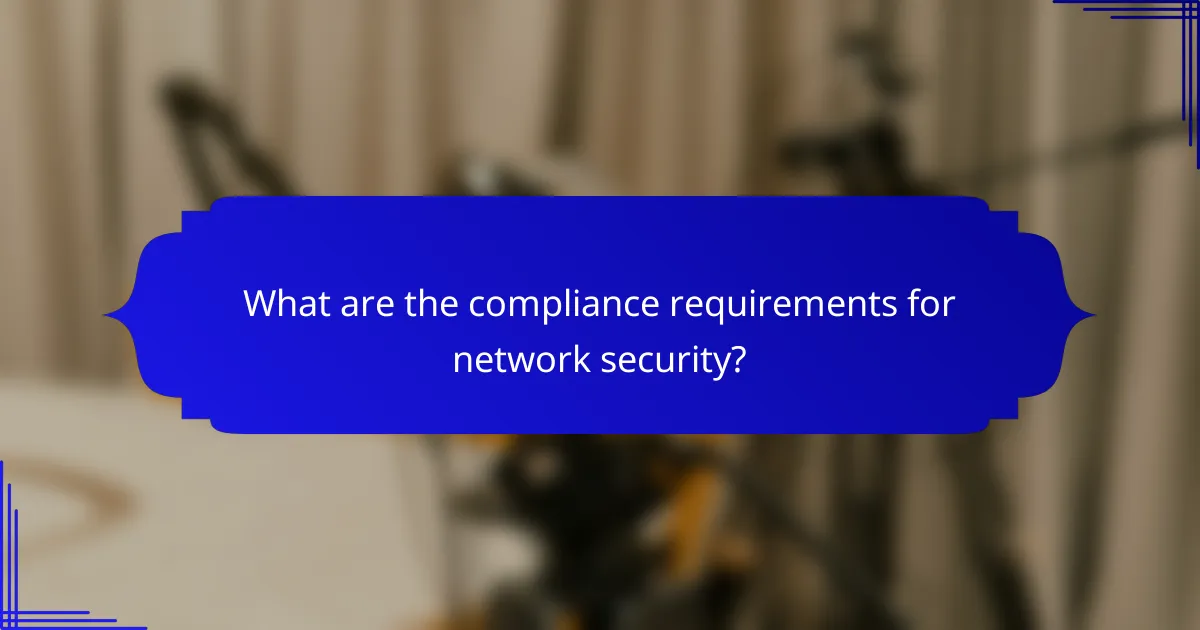
What are the compliance requirements for network security?
Compliance requirements for network security involve adhering to various regulations and standards that protect sensitive data and ensure the integrity of networks. Organizations must understand these requirements to avoid legal issues and maintain customer trust.
Overview of New Zealand regulations
In New Zealand, compliance with the Privacy Act 2020 is crucial for organizations handling personal information. This act mandates that businesses take reasonable steps to protect personal data from unauthorized access and breaches. Additionally, the Health Information Privacy Code 2020 sets specific requirements for health-related data.
Organizations may also need to comply with the New Zealand Cyber Security Strategy, which outlines best practices for safeguarding networks and information systems. Following these regulations helps ensure that organizations are prepared for potential cyber threats.
Industry-specific compliance standards
Different industries in New Zealand may have specific compliance standards. For example, the Payment Card Industry Data Security Standard (PCI DSS) is essential for businesses that handle credit card transactions. Compliance with PCI DSS involves implementing security measures to protect cardholder data.
Similarly, organizations in the financial sector must adhere to the Anti-Money Laundering and Countering Financing of Terrorism Act, which includes provisions for secure data handling and reporting suspicious activities. Understanding these industry-specific standards is vital for maintaining compliance and avoiding penalties.
Penalties for non-compliance
Non-compliance with network security regulations in New Zealand can lead to significant penalties, including fines and legal action. Under the Privacy Act 2020, organizations may face fines of up to NZD 10 million for serious breaches. This financial risk emphasizes the importance of adhering to compliance requirements.
In addition to monetary penalties, non-compliance can damage an organization’s reputation and erode customer trust. Companies should regularly review their compliance status and implement necessary measures to avoid these consequences.
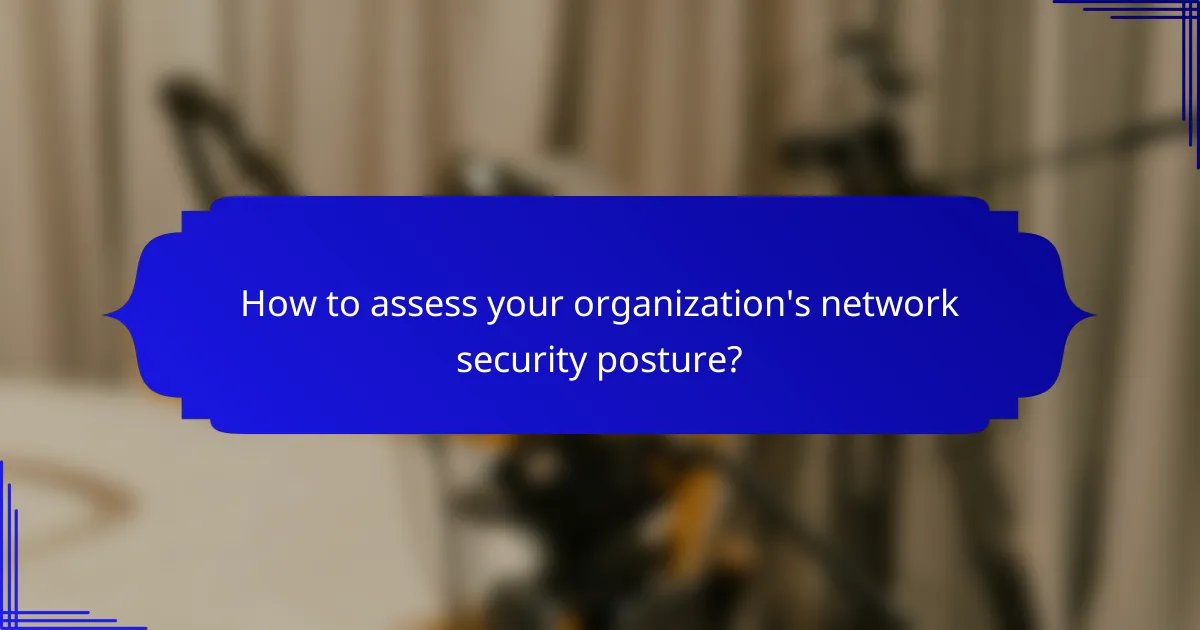
How to assess your organization’s network security posture?
To assess your organization’s network security posture, start by evaluating existing vulnerabilities, potential threats, and compliance with relevant regulations. This process involves systematic analysis and the implementation of best practices to strengthen your security defenses.
Risk assessment methodologies
Risk assessment methodologies help organizations identify and prioritize risks to their network security. Common approaches include qualitative assessments, which categorize risks based on likelihood and impact, and quantitative assessments, which assign numerical values to risks for more precise analysis.
Consider using frameworks like NIST SP 800-30 or ISO 27005, which provide structured processes for conducting risk assessments. These methodologies guide organizations in identifying vulnerabilities, assessing threats, and determining the potential impact on operations.
Tools for vulnerability scanning
Vulnerability scanning tools are essential for identifying weaknesses in your network security. Popular options include Nessus, Qualys, and OpenVAS, which automate the scanning process and provide detailed reports on vulnerabilities found.
When selecting a tool, consider factors such as ease of use, integration capabilities, and the frequency of updates. Regular scans, ideally monthly or quarterly, can help maintain an up-to-date understanding of your network’s security posture and ensure compliance with industry standards.
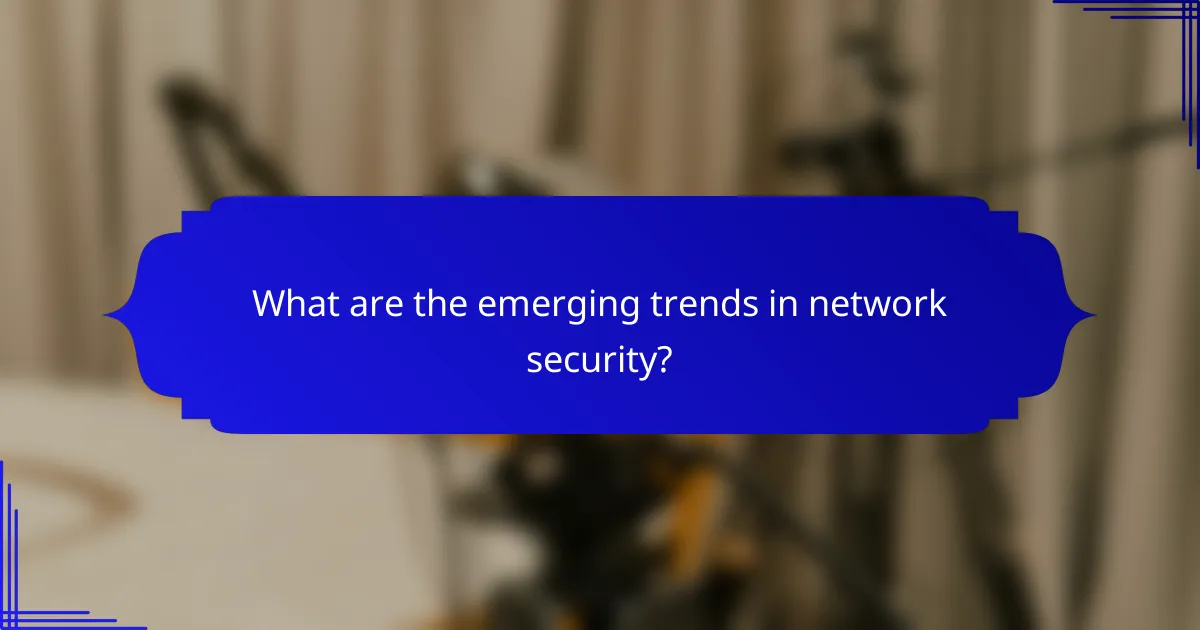
What are the emerging trends in network security?
Emerging trends in network security focus on advanced technologies and strategies to combat evolving threats. Key developments include the adoption of artificial intelligence, zero trust architecture, and increased emphasis on compliance with data protection regulations.
Software Costs
The costs associated with network security software can vary significantly based on features, scalability, and vendor reputation. Businesses should expect to invest in a combination of firewalls, intrusion detection systems, and endpoint protection, which can range from a few hundred to several thousand dollars annually.
When budgeting for software, consider not only the initial purchase price but also ongoing maintenance and subscription fees. It’s wise to evaluate multiple vendors to find a solution that fits both your security needs and budget constraints.
Training
Training is essential for ensuring that employees understand network security protocols and best practices. Regular training sessions can help reduce the risk of human error, which is a common vulnerability in many organizations.
Investing in comprehensive training programs can cost anywhere from a few hundred to several thousand dollars per employee, depending on the depth of the training. Consider incorporating simulated phishing attacks and hands-on workshops to enhance learning outcomes.
Compliance
Compliance with regulations such as GDPR, HIPAA, or PCI DSS is critical for businesses handling sensitive data. Non-compliance can lead to significant fines and damage to reputation, making it essential to stay informed about relevant laws and standards.
To ensure compliance, organizations should conduct regular audits and risk assessments. Allocating resources for compliance management tools can help streamline the process, with costs typically ranging from low hundreds to several thousand dollars annually, depending on the complexity of the requirements.
